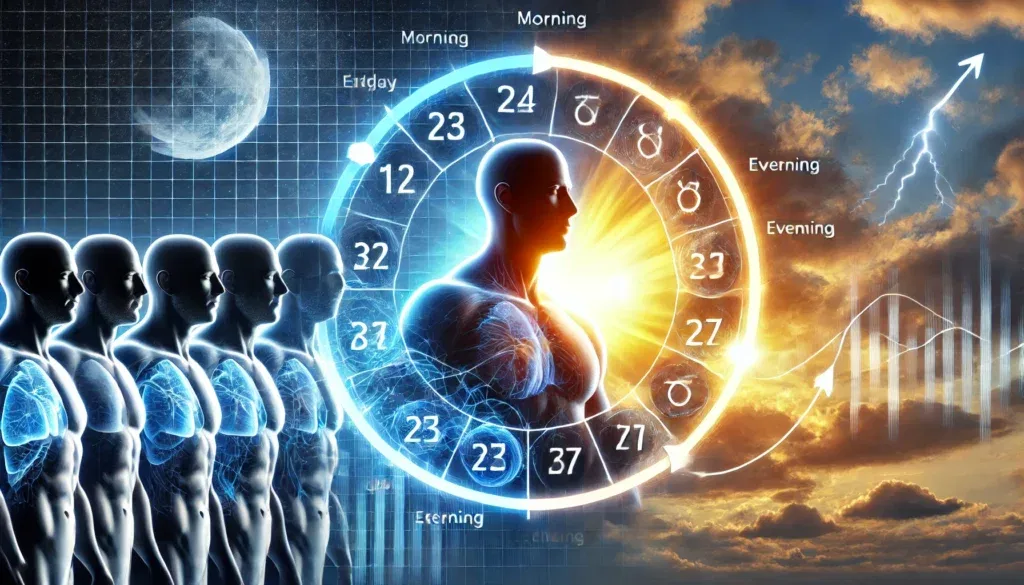Testosterone, the primary male sex hormone, plays a crucial role in numerous physiological functions, including muscle growth, bone density, fat distribution, red blood cell production, and reproductive health. However, testosterone levels fluctuate throughout the day, affecting how they should be measured for accuracy. Understanding these variations is essential for diagnosing testosterone deficiencies or imbalances. This article explores how testosterone levels change by time of day, why they fluctuate, and the best times for testing.
You may also like: How to Get Your Testosterone Levels Checked: Best At-Home and Lab Testing Options
Understanding Circadian Rhythms and Hormonal Fluctuations
Testosterone levels follow a circadian rhythm, meaning they rise and fall within a 24-hour cycle. The body’s internal clock, governed by the hypothalamus, influences the secretion of hormones, including testosterone. For most men, levels peak in the early morning, typically between 7:00 and 10:00 a.m., and decline as the day progresses. This pattern is more pronounced in younger men and diminishes with age.
The fluctuation in testosterone levels is linked to sleep cycles and the body’s endocrine system. During deep sleep, the pituitary gland releases pulses of luteinizing hormone (LH), which stimulates the testes to produce testosterone. This nocturnal surge explains why morning levels are higher. As the day progresses, stress, physical activity, and metabolism contribute to a gradual decline in circulating testosterone.

When is Testosterone Highest?
Testosterone levels are at their highest in the early morning hours. Research indicates that men experience peak testosterone secretion between 4:00 and 8:00 a.m., with levels declining gradually thereafter. The early morning peak is attributed to the interplay between sleep quality and the hypothalamic-pituitary-gonadal (HPG) axis.
Factors such as sleep deprivation, shift work, and irregular sleep schedules can disrupt this natural rhythm. Studies show that insufficient sleep can lead to lower morning testosterone levels, reinforcing the importance of maintaining a consistent sleep schedule. For individuals undergoing testosterone testing, prioritizing quality sleep in the days leading up to the test can enhance accuracy.
When is Testosterone Lowest?
Testosterone levels reach their lowest point in the evening, typically between 5:00 and 9:00 p.m. This decline is a result of the body’s natural metabolic processes and exposure to stressors throughout the day. As men age, the diurnal variation in testosterone levels becomes less pronounced, leading to a more consistent but lower baseline level.
Stress and cortisol, the body’s primary stress hormone, play a significant role in suppressing testosterone. Elevated cortisol levels, often caused by chronic stress, can inhibit testosterone production by disrupting LH secretion. This interaction highlights the importance of stress management in maintaining optimal testosterone levels.
How Age Affects Testosterone Fluctuations
Age-related changes in testosterone levels are well-documented. Young men (ages 20–30) typically exhibit a pronounced diurnal rhythm, with sharp morning peaks and significant evening declines. However, by middle age (40–50), the difference between morning and evening levels narrows. By the time men reach their 60s and beyond, the daily fluctuations become minimal, and total testosterone levels decrease overall.
Understanding age-related testosterone changes is crucial for interpreting test results. A 25-year-old man with a morning testosterone level of 600 ng/dL and an evening level of 400 ng/dL may still be within the normal range, whereas a 60-year-old man with similar values may be considered to have low testosterone. This nuance underscores the importance of age-specific reference ranges in clinical assessments.
Best Time of Day for Testosterone Testing
For accuracy, medical professionals recommend measuring testosterone levels in the morning, typically between 7:00 and 10:00 a.m. This recommendation is based on the fact that testosterone is at its highest during this time, providing a reliable baseline for assessment. The Endocrine Society and other medical organizations advise morning testing, particularly for men under 40, due to their pronounced diurnal variation.
However, for older men, testing time may be less critical because their daily fluctuations are less dramatic. In some cases, multiple tests taken at different times on separate days may be necessary to confirm a diagnosis of low testosterone. Physicians may also recommend additional testing, such as free testosterone measurements or luteinizing hormone (LH) levels, to gain a more comprehensive understanding of a patient’s hormonal health.
Factors That Influence Daily Testosterone Variations
Several factors can impact testosterone levels throughout the day, affecting test results. Sleep quality is one of the most significant determinants. Studies have shown that men who experience fragmented or insufficient sleep have lower morning testosterone levels. This is because testosterone production primarily occurs during the deep stages of sleep.
Diet and nutrition also play a role. Consuming high-sugar meals can lead to temporary reductions in testosterone due to insulin spikes. Similarly, excessive alcohol consumption, particularly in the evening, can disrupt testosterone synthesis and lead to artificially low readings the following morning.
Exercise can acutely affect testosterone levels as well. Resistance training and high-intensity interval training (HIIT) can temporarily boost testosterone, while prolonged endurance exercise, such as marathon running, may suppress it. Timing of exercise relative to testing should be considered to avoid skewed results.
How to Prepare for a Testosterone Test
To obtain the most accurate testosterone measurement, certain precautions should be taken. First, individuals should ensure they get at least seven to eight hours of quality sleep before testing. Since fasting can influence hormone levels, most physicians recommend taking the test in a fasted state, particularly if other metabolic markers (such as glucose or cholesterol) are being evaluated simultaneously.
Avoiding strenuous exercise the day before testing is also advised, as intense physical activity can lead to transient fluctuations. Additionally, reducing alcohol intake and managing stress levels can help prevent artificially low testosterone readings. If a person is taking medications that may influence testosterone, such as corticosteroids or opioid pain relievers, they should inform their healthcare provider before testing.
The Role of Multiple Testosterone Measurements
Given the natural fluctuations in testosterone levels, a single test may not always provide an accurate assessment. Physicians often recommend taking at least two separate morning tests on different days to confirm low testosterone. In some cases, additional measurements of free testosterone, SHBG (sex hormone-binding globulin), and LH can provide deeper insights into hormonal balance.
For men with borderline or inconsistent results, an endocrinologist may order a more comprehensive hormonal panel, including DHEA, estradiol, and cortisol levels. This broader evaluation helps identify underlying conditions that may be contributing to low testosterone, such as metabolic syndrome or hypogonadism.

Frequently Asked Questions (FAQ) on Testosterone Levels by Time of Day
1. Why do testosterone levels fluctuate throughout the day?
Testosterone levels by time of day naturally fluctuate due to the body’s circadian rhythm. This hormonal cycle is regulated by the brain’s hypothalamus and pituitary gland, which respond to light exposure and sleep-wake patterns. Typically, testosterone levels peak in the early morning, shortly after waking, and gradually decline throughout the day. By evening, levels reach their lowest point, which is why many individuals experience reduced energy and libido later in the day. Understanding these fluctuations can help individuals optimize their workout schedules, productivity, and overall well-being.
2. When is testosterone lowest, and what factors can influence this decline?
Testosterone is lowest in the evening, typically between 4 PM and 8 PM, although exact times can vary depending on sleep quality, stress levels, and age. Poor sleep habits, excessive alcohol consumption, and high levels of chronic stress can accelerate the decline of testosterone levels by time of day. Additionally, diet and physical activity also play a role; a sedentary lifestyle and a diet high in processed foods may contribute to lower testosterone levels. By maintaining a healthy sleep schedule and reducing stress, individuals can help mitigate excessive evening declines in testosterone.
3. Can adjusting my daily routine help optimize my testosterone levels?
Yes, aligning your daily activities with your natural hormonal fluctuations can help optimize testosterone production. For instance, scheduling strength training or high-intensity workouts in the morning, when testosterone levels are at their highest, may improve performance and muscle gains. Additionally, consuming nutrient-dense foods such as lean proteins, healthy fats, and zinc-rich foods can support testosterone production throughout the day. Prioritizing quality sleep and reducing screen time before bed can also help maintain stable testosterone levels by time of day. Small changes in routine can make a significant impact on long-term hormonal balance.
4. How does sleep impact testosterone levels by time of day?
Sleep is crucial for testosterone production, with the majority of testosterone being synthesized during deep REM sleep. Studies show that individuals who sleep fewer than five hours per night can experience a significant decline in testosterone levels. When is testosterone lowest? It tends to drop dramatically when sleep is disrupted or inadequate. To maximize hormone production, aim for at least seven to nine hours of uninterrupted sleep per night. Practicing good sleep hygiene, such as maintaining a consistent bedtime and reducing exposure to blue light, can help support natural testosterone rhythms.
5. Are testosterone fluctuations the same for all men?
No, testosterone levels by time of day can vary based on factors such as age, genetics, and lifestyle. Young men generally experience higher morning testosterone peaks compared to older men, whose hormonal rhythms may become less pronounced over time. Additionally, individuals with conditions such as sleep apnea, obesity, or chronic stress may see more dramatic fluctuations or overall lower levels. While the general pattern of testosterone peaking in the morning and declining by evening holds true, the degree of fluctuation is unique to each individual.
6. How do workouts influence testosterone fluctuations?
Exercise, particularly resistance training and high-intensity interval training (HIIT), can temporarily boost testosterone levels. The effect is more pronounced when working out in the morning, aligning with the body’s natural peak in testosterone levels by time of day. However, overtraining or excessive endurance exercise without adequate recovery can lead to a long-term decline in testosterone. To maintain optimal levels, balance strength training with sufficient rest, proper nutrition, and stress management techniques. Strategic workout timing can enhance the body’s ability to produce and sustain healthy testosterone levels.
7. Can stress and mental health affect testosterone levels?
Yes, chronic stress triggers the release of cortisol, a hormone that can suppress testosterone production. High cortisol levels interfere with the body’s ability to maintain stable testosterone levels by time of day, leading to fatigue, irritability, and reduced libido. Managing stress through mindfulness, meditation, and relaxation techniques can help balance these hormones. Additionally, engaging in hobbies, socializing, and maintaining a positive mindset contribute to overall well-being and hormone regulation. Prioritizing mental health is just as important as diet and exercise for maintaining optimal testosterone levels.
8. Does intermittent fasting affect testosterone levels by time of day?
Intermittent fasting can have both positive and negative effects on testosterone production. Short-term fasting has been shown to increase luteinizing hormone (LH), which stimulates testosterone production. However, prolonged fasting or calorie restriction can lead to a drop in overall testosterone levels, particularly when combined with inadequate nutrient intake. When is testosterone lowest during fasting? It typically declines in the late afternoon and evening, especially if the fasting window extends into these hours. Ensuring adequate protein and fat intake during eating windows can help support stable testosterone levels.
9. How do testosterone levels change with age?
Testosterone naturally declines with age, with levels beginning to drop around 1% per year after the age of 30. While this decline is gradual, it can become more noticeable by middle age, leading to reduced muscle mass, energy levels, and libido. When is testosterone lowest in aging men? Typically, the evening decline becomes more pronounced, and the morning peak may be less significant. However, lifestyle modifications, strength training, and hormone therapy (if necessary) can help mitigate age-related declines and support overall hormonal balance.
10. Can diet influence testosterone levels by time of day?
Yes, diet plays a crucial role in regulating testosterone. Nutrient-dense foods such as eggs, fatty fish, lean meats, nuts, and vegetables help sustain healthy testosterone levels. Processed foods, excessive sugar, and high alcohol intake can lead to insulin resistance and inflammation, which negatively impact hormone balance. When is testosterone lowest due to dietary factors? It tends to be lower in individuals who consume a diet high in refined carbs and low in essential micronutrients. Ensuring adequate intake of vitamin D, zinc, and magnesium can help support stable testosterone levels throughout the day.

Conclusion: Optimizing Testosterone Testing for Accurate Diagnosis
Understanding how testosterone levels fluctuate throughout the day is essential for obtaining accurate test results. Since testosterone follows a circadian rhythm, measuring levels in the morning between 7:00 and 10:00 a.m. provides the most reliable data, particularly for younger men. However, factors such as age, sleep quality, stress, and lifestyle choices can influence testosterone readings.
For those undergoing testosterone testing, proper preparation—including adequate sleep, fasting, and avoiding intense exercise—can help ensure accuracy. In cases of suspected low testosterone, multiple tests may be needed to confirm a diagnosis, along with additional hormonal assessments. By recognizing the significance of daily testosterone variations, individuals and healthcare providers can make informed decisions regarding hormonal health and potential treatment options.
testosterone production cycle, circadian rhythm testosterone, morning vs evening testosterone levels, best time to test testosterone, testosterone and sleep quality, stress impact on testosterone, age-related testosterone decline, testosterone testing preparation, hormone health optimization, endocrine system function, testosterone levels fluctuations, when to test for low testosterone, natural testosterone boosters, lifestyle factors affecting testosterone, effects of exercise on testosterone, cortisol and testosterone relationship, testosterone testing guidelines, testosterone replacement therapy considerations, SHBG and testosterone balance, hormonal health diagnostics
Further Reading:
(372) Does Age Predict the Difference in Morning vs Afternoon Testosterone Levels?
Is a fasting testosterone level really necessary for the determination of androgen status in men?
Disclaimer: The information provided in this article is for general informational purposes only. The content does not constitute professional advice of any kind, including but not limited to medical, legal, or financial advice. HisHealthMag and its contributors make no representations or warranties regarding the accuracy, completeness, or reliability of the information presented. Always seek the advice of a qualified professional for any specific concerns or questions you may have. Neither HisHealthMag nor its authors assume any responsibility or liability for any actions taken based on the information provided in this article. The views and opinions expressed are those of the author(s) and do not necessarily reflect the official policy or position of HisHealthMag.





